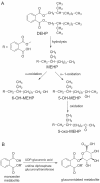Di-(2-ethylhexyl) phthalate and autism spectrum disorders
- PMID: 22537663
- PMCID: PMC3363982
- DOI: 10.1042/AN20120015
Di-(2-ethylhexyl) phthalate and autism spectrum disorders
Abstract
ASDs (autism spectrum disorders) are a complex group of neurodevelopment disorders, still poorly understood, steadily rising in frequency and treatment refractory. Extensive research has been so far unable to explain the aetiology of this condition, whereas a growing body of evidence suggests the involvement of environmental factors. Phthalates, given their extensive use and their persistence, are ubiquitous environmental contaminants. They are EDs (endocrine disruptors) suspected to interfere with neurodevelopment. Therefore they represent interesting candidate risk factors for ASD pathogenesis. The aim of this study was to evaluate the levels of the primary and secondary metabolites of DEHP [di-(2-ethylhexyl) phthalate] in children with ASD. A total of 48 children with ASD (male: 36, female: 12; mean age: 11 ± 5 years) and age- and sex-comparable 45 HCs (healthy controls; male: 25, female: 20; mean age: 12 ± 5 years) were enrolled. A diagnostic methodology, based on the determination of urinary concentrations of DEHP metabolites by HPLC-ESI-MS (HPLC electrospray ionization MS), was applied to urine spot samples. MEHP [mono-(2-ethylhexenyl) 1,2-benzenedicarboxylate], 6-OH-MEHP [mono-(2-ethyl-6-hydroxyhexyl) 1,2-benzenedicarboxylate], 5-OH-MEHP [mono-(2-ethyl-5-hydroxyhexyl) 1,2-benzenedicarboxylate] and 5-oxo-MEHP [mono-(2-ethyl-5-oxohexyl) 1,2-benzenedicarboxylate] were measured and compared with unequivocally characterized, pure synthetic compounds (>98%) taken as standard. In ASD patients, significant increase in 5-OH-MEHP (52.1%, median 0.18) and 5-oxo-MEHP (46.0%, median 0.096) urinary concentrations were detected, with a significant positive correlation between 5-OH-MEHP and 5-oxo-MEHP (rs = 0.668, P<0.0001). The fully oxidized form 5-oxo-MEHP showed 91.1% specificity in identifying patients with ASDs. Our findings demonstrate for the first time an association between phthalates exposure and ASDs, thus suggesting a previously unrecognized role for these ubiquitous environmental contaminants in the pathogenesis of autism.
Figures



References
-
- Alcaro MC, Paolini I, Lolli F, Migliorini P, Rovero P, Papini AM. Peptide contribution to the diagnosis of autoimmune diseases. Chemistry Today. 2009;27:11–14.
-
- Anney RJL, Kenny EM, O'Dushlaine C, Yaspan BL, Parkhomenka E, Buxbaum JD, Sutcliffe J, Gill M Gallagher. Gene-ontology enrichment analysis in two independent family-based samples highlights biologically plausible processes for autism spectrum disorders. Eur J Hum Genet. 2011;19:1082–1089. - PMC - PubMed
-
- Bauer ML, Herrmann R. Estimation of the environmental contamination by phthalic acid esters leaching from household wastes. Sci Total Environ. 1997;208:49–57. - PubMed
-
- Blount BC, Milgram KE, Silva MJ, Malek NA, Reidy JA, Needham LL, Brock JW. Quantitative detection of eight phthalate metabolites in human urine using HPLC-APCIMS/MS. Anal Chem. 2000;72:4127–4134. - PubMed
Publication types
MeSH terms
Substances
LinkOut - more resources
Full Text Sources

